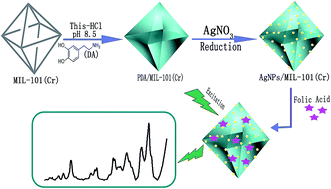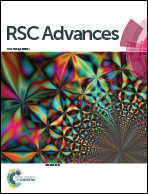Poly(dopamine) assisted in situ fabrication of silver nanoparticles/metal–organic framework hybrids as SERS substrates for folic acid detection
Abstract
In this contribution, a new in situ strategy for the preparation of AgNPs/MIL-101(Cr) hybrids as SERS substrates for folic acid detection was reported. In Tris–HCl buffer solution (pH = 8.5), poly(dopamine) (PDA) could be formed by self-polymerization of dopamine (DA), and was then effectively attached onto the surface of MIL-101(Cr) for further reduction of Ag+. By this strategy, AgNPs could be efficiently anchored on MIL-101(Cr) to form AgNPs/MIL-101(Cr) hybrids, which exhibited strong enrichment of folic acid (FA) due to electrostatic interaction, and the anchored AgNPs greatly enhanced the Raman signals of FA. Thus, the as-prepared hybrids have been used as excellent surface enhanced Raman scattering (SERS) substrates for the sensitive and selective detection of FA. Under the optimal experimental conditions, the SERS method shows good linearity in the range from 0.5 μM to 25 μM for FA with a correlation coefficient of 0.990, the detection limit was calculated to be 0.3 μM ± 0.02 μM. Moreover, it was successfully applied to detect FA in real samples with satisfactory results. These results demonstrated that the proposed SERS system has great practicability for chemical and biological assay applications, and the AgNPs/MIL-101(Cr) hybrids also offers potential for targeting cancer cells.


 Please wait while we load your content...
Please wait while we load your content...